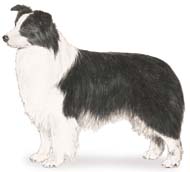INSTANT PROMOTION - LIMITED TIME OFFER - GET YOUR PUPPY COUPON TODAY
Hicksville: 516-938-7877
Lynbrook: 516-825-7877
Hicksville: 516-938-7877
Lynbrook: 516-825-7877
Currently we do not have any Border Collie Puppies available.
Please complete the form below to be notified when they are back in our stores.

Height: Males: 20 – 23 inches; Females: 18 – 21 inches. Weight: 30 – 50 lbs
Colors: Two varieties – rough and smooth. Rough is flat or slightly wavy and medium length. Smooth is short. Both are thick and straight. Coat: Solid, bicolor, tricolor, merle, sable in colors of black, white, blue, chocolate, red – with or without tan points and white markings. White should never predominate.
Temperament: BorderCollies areintelligent, active, loyal, affectionate and responsive. They are hard working and very energetic. If you are considering buying this dog be sure the Collie has an outlet for his intense energy. They are reserved and protective towards strangers, but loving towards family. They can be disastrously destructive if left alone or not given something to do. With Children: Somewhat. They are affectionate and obedient, but they have a high prey drive and may not be good in homes with small children. If they are not given a job to do, they are known to herd children and may nip them if they aren’t cooperating. With Pets: Yes, gets along well with other animals, but will herd and chase them if they run. Special Skills: The Border Collie is an excellent sheepdog and cattle-herder.
Watch-dog: High. Border Collies are alert and tend to bark. Guard-dog: Low.
Care and Exercise: Border Collies need weekly brushing to remove dead hairs. Bathe when necessary. Check ears and coat regularly for ticks. The Border Collies needs extensive exercise and mental stimulation. They need a job or activity to do every day. An idle Border Collie will become badly behaved and possibly aggressive, creating disastrous effects on the house. Training: Border Collies excel in sports like obedience, agility and sheepdog trials. Famous throughout the world for their tremendous intelligence and their desire to please, they are always quick and eager to learn new commands. They are often known as “farm collies” or “working collies”, and are excellent stock and sheep-herders. They are superb in obedience trials. Learning Rate: High. Border Collies are bred for their intelligence.
Activity: Very High, bores easily if left alone. Needs a job to accomplish. They are often referred to as “working collies”. Special Needs: Exercise, fenced yard, job or activity, socialization, training and a leash. Living Environment: Rural setting with lots of work such as a cattle ranch. This is not a breed for the couch potato or absentee owner, as a Border Collie has boundless energy and a great desire to work. If no job is given to them they may resort to herding anything, including children. One Collie in Hawaii was known to have been herding coconuts. Border Collies are not apt to be good dogs for children either, due to their strong herding instincts. They will try to herd children if not given a job to do, and therefore may end up nipping them if they do not cooperate.
Health Issues: PRA (Progressive retinal atrophy), hip dysplasia. Other health concerns include Osteochondritis dessicans (OCS), Ceriod Lipofuscinosis, lens luxation, seizures and heart defects. Collie owners have long been concerned about the popularity of looks emphasized over workability, and therefore have worked to make sure the breed remains focused on health, not appearance.
Life Span: 9 – 15 years. Border Collies are long-lived. They can last well into their teens. Litter Size: 6 – 8
Country of Origin: Great Britain History: Border Collies were developed from such breeds as the Bearded Collie, Harlequin, Bob-tailed Sheepdog and Smithfield. It is a descendant of the collies developed along the border of England and Scotland, and were named for the Border counties of England and Scotland. Bred for stamina and intelligence, the Border Collie has the natural instinct to herd. They have been in sheepdog competitions since 1873 in England and have since participated in the United States. Most of the herding dogs the Collie was said to have descended from often used nipping and barking to encourage sheep to move, but a young dog named Hemp developed the skill of “eyeing” the sheep, not barking or nipping, to get them to move. Hemp is considered to be the father of the Border Collie breed. It wasn’t until the mid 1960s that the Kennel Club began to register the Border Collie, and in 1995 the breed was finally registered. Great Britain registered the breed in the British Kennel Club in 1976. The Border Collie quickly amazed shepherds and regular civilians alike with its hypnotizing gaze that moved even the most stubborn of sheep.
First Registered by the AKC: 1995 AKC Group: Herding Class: Herding Registries: AKC, ANKC, CKC, FCI (Group 1), KC (GB), UKC